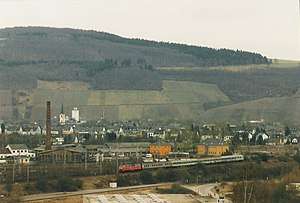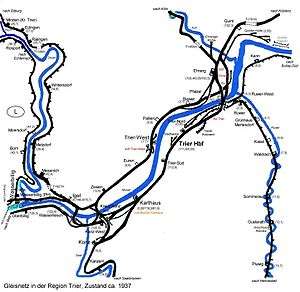Ehrang station
Ehrang station is, after Trier Hauptbahnhof, the second most important station in the city of Trier in the German state of Rhineland-Palatinate. The station forms a railway junction with a former marshalling yard, which is still partly used as a freight yard. At the station, the Eifel Railway from Cologne connects with the Koblenz–Trier railway. Until 1983, Ehrang station was also the starting point of the Trier West Railway to Igel, which connected with Wasserbillig / Luxembourg.
| Through station | |
 Former marshalling yard | |
| Location | Ehrangerstraße 3-5, Ehrang, Trier, Rhineland-Palatinate Germany |
| Coordinates | 49°48′07″N 6°41′08″E |
| Line(s) |
|
| Platforms | 4 (3 regularly used) |
| Construction | |
| Architect | Carl Julius Raschdorff |
| Architectural style | Revivalism / Jugendstil |
| Other information | |
| Station code | 1488[1] |
| DS100 code | SEG[2] |
| IBNR | 8000370 |
| Category | 5[1] |
| Website | www.bahnhof.de |
| History | |
| Opened | 25 March 1871 |

History
Ehrang station was opened in 1870 by the Rhenish Railway Company (Rheinische Eisenbahn-Gesellschaft). General operations began on 25 March 1871 at the opening of the railway from Trier to Gerolstein, including the section of line west of the station that became part of the Trier West Railway. The station building at Ehrang resembled those along this line, which were each built as small "palaces" (Schlösser). These were financed from the money that France had to pay as reparations to Germany after the Franco-Prussian War. It was expected that it would take many years to settle this debt. But in a one-time payment the whole debt was repaid. Now the German Empire could afford to erect these stations.[3] The design of the building in Ehrang comes from the famous architect Julius Carl Raschdorff, who also designed the stations of Kyllburg, Bitburg-Erdorf and Speicher.[4]
As part of the strategic Kanonenbahn ("cannons railway") from Berlin to Metz, now in France, the railway from Koblenz along the Mosel to Trier was built between 1874 and 1879, making Ehrang station a small railway junction.
The entrance building is still largely in its original state, although it is no longer owned by Deutsche Bahn.
Entrance building
The entrance building, including the side buildings and the water tower, are listed under the Rhineland-Palatinate Monument Protection Act (Denkmalschutzgesetz) as a cultural monument.[5]
The water tower is a spherical water tank, which was built on a cone-shaped base of cast iron plates between 1907 and 1913. Today, the water tower is a relatively rare representative of the water towers built around 1900 to the Intze design.
The ensemble of the entrance building, rail sheds and employees accommodation is a picturesque group building with red sandstone façades.[6]
The whole ensemble is listed at the address of Ehranger Straße 2, 3, 4, 5, 7 and 8.
 Entrance building (no longer in use) seen from the tracks
Entrance building (no longer in use) seen from the tracks Platform 1: the roofing of the underpass has suffered greatly from wear and vandalism
Platform 1: the roofing of the underpass has suffered greatly from wear and vandalism Adjacent building, on platform 1 south of the entrance building
Adjacent building, on platform 1 south of the entrance building Water tower
Water tower
Rail services
The fares of the Verkehrsverbundes Region Trier (VRT) as well as the fares of Deutsche Bahn are valid on all public transport in Ehrang.
The following services stop at Ehrang station, each running hourly:
- theEifel-Bahn (RB 22) Gerolstein–Trier
- the Moseltal-Bahn (RB 81) Koblenz–Wittlich–Trier and
- the Elbling-Express (RB 82) (Wittlich–)Trier–Perl (only Mon–Fri)
Long-distance services do not stop in Ehrang.
References
- "Stationspreisliste 2020" [Station price list 2020] (PDF) (in German). DB Station&Service. 4 November 2019. Retrieved 15 November 2019.
- Eisenbahnatlas Deutschland (German railway atlas) (2009/2010 ed.). Schweers + Wall. 2009. ISBN 978-3-89494-139-0.
- Pater Josef Böffgen (1978). Brunnenstadt Gerolstein alte und neue Bilder (in German). Europäische Bibliothek.
- Manfred Stoos, Bitburg-Erdorf, 2010
- "Nachrichtliches Verzeichnis der Kulturdenkmäler Kreisfreie Stadt Trier" (pdf) (in German). Koblenz: Generaldirektion Kulturelles Erbe Rheinland-Pfalz. 3 August 2016. p. 47. Retrieved 24 March 2017.
- Heritage list (in German). Generaldirektion Kulturelles Erbe, Rheinland-Pfalz. 2010.